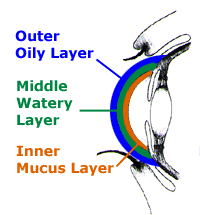Understanding Dry-Eye Syndrome
Tears often seem to be an inconvenience – when we cry or when they run from our eyes due to eye irritation. But actually, they have a very important function. Our tears cover the surface of the eye in a fine film, spread by blinking. This tear film makes the surface of the eye smooth and optically clear. Without tears, good vision is not possible.
Some people do not produce enough quality tears to keep the eye lubricated. This condition is called Dry-Eye Syndrome. Dry eyes are demonstrated by burning, stinging, scratchiness, stringy mucus, and increased irritation from smoke. Problems with contact lenses can be caused by dry eyes and make it impossible for the individual to wear contact lenses.
However odd it seems, increased tearing can be a symptom of dry eye. This is because when tear secretion is diminished and the eye is dry, excess tears are produced to overcome the eye irritation. So even though the eye is basically dry, excess tearing can camouflage the dryness.
What Causes Dry Eyes?
It is normal for tear production to decrease with age. Although dry eye can occur at any age for both men and women, women around the age of menopause are especially prone to dry eye.
Other conditions increase the likelihood of dry eyes. Arthritis increases the possibility of dry eye. Also certain drugs and medications can produce dry eye by reducing normal tear secretion. If maintenance on medication is essential, the dry eye condition must be treated.
 |
Three layers make up the thin tear film which coats the surface of eye
|
How are Dry Eyes Diagnosed?
Through examination, Dr. Moretsky and Dr. Cassidy can diagnose the condition of dry eye syndrome. Sometimes, it is necessary to do tests which measure tear production. Many people realize that they have dry eye and use over-the-counter Artificial Tears as a remedy. In many cases this is fine. However, extreme dry eye can cause serious eye damage, so it is wise to have a reliable diagnosis for the condition and undergo treatment.
How is Dry Eye Syndrome Treated?
The basic treatment of dry eye is replacement of natural tears with Artificial Tears. These Artificial Tears are sold without a prescription. They can be used as often as you feel a need for them without fear of eye damage.
Artificial Tears come in preserved and unpreserved versions. Preserved tears come in regular eyedrop bottles. Unpreserved comes in small droperettes that are more expensive due to the package. Bedtime ointments are recommended to treat the scratchiness that often occurs after awakening in the morning.
Suffers from dry eye should avoid anything that adds dryness to the air, such as overheated rooms, hair dryers, windy days, and air-conditioning vents blowing in your face. Even allergy medications that cause drying can add to dryness of your eyes.
Punctal Plugs
The eye is normally kept moist by tears, secreted through the tear gland and onto the surface of the eye. Tears are then drained through a tear drainage canal. The doctors can implant either temporary or permanent “drain” plugs to preserve your tears. The plugs block the drain, like a “stopper” and allow the naturally secreted fluid to remain longer on the surface of the eye. This procedure can eliminate or reduce the need to constantly add supplemental tears.
Prescription Eyedrop Therapy
Ziidra® or topical cyclosporin are prescription eyedrops used twice a day that increases tear production by breaking the inflammation loop between the surface of the eye at the lacrimal or tear gland. Many patients obtain excellent results, but therapy should be sustained and may require many weeks of use before any noticeable improvement occurs. This Rx can be costly if not covered under prescription drug benefits.
Other Options
Other options of treatment regarding dry eye associated with eyelid gland dysfunction include application of moist warm compresses to the eyelids and lid hygiene using a diluted baby shampoo and water scrubs. Some patients may benefit from low dose oral antibiotics and/or dietary supplements, including Omega 3 and 6 fatty acids.
Conclusion
Our understanding of dry eyes has substantially increased and so has our treatment arsenal. If you have any questions about any of the considerations above, do not hesitate to ask Dr. Moretsky or Dr. Cassidy.
Learn More
Learn about the Doctors that can treat your dry eyes
Read about other eye problems
Understand Cataract Surgery





